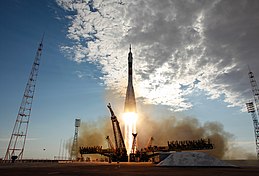Soyuz TMA-M
 | |
| Manufacturer | Energia |
|---|---|
| Country of origin | |
| Operator | Roscosmos |
| Applications | ISS crew transport |
| Specifications | |
| Regime | Low Earth orbit |
| Design life | Up to six months docked to ISS |
| Production | |
| Status | Retired |
| Launched | 20 |
| Maiden launch | 7 October 2010 (Soyuz TMA-01M) |
| Last launch | 18 March 2016 (Soyuz TMA-20M) |
| Related spacecraft | |
| Derived from | Soyuz TMA |
| Derivatives | Soyuz MS |
The Soyuz TMA-M was a spacecraft developed by Energia and operated by Roscosmos for human spaceflight. Introduced in 2010, it is a revision of the Soyuz spacecraft with upgrades over its predecessor, the Soyuz TMA.
The primary difference between the Soyuz TMA-M and the Soyuz TMA was that it replaced several pieces of outdated equipment including the 70-kilogram (150 lb) Argon main computer[1] and its analogue avionics, many of which were no longer in production, with a new digital computer, the TsVM-101 and digital avionics.[2] The changes reduced the vehicle's total mass by 70 kilograms (150 lb).[3]
NASA astronaut Scott Kelly, a member of the Soyuz TMA-01M crew, praised the spacecraft's new digital displays, noting that they made flying easier and less demanding.[4]
Additionally, power consumption was reduced throughout the ship, contributing to its overall efficiency..[2] There are also changes to the spacecraft's structure, such as replacing the magnesium alloy used in the instrument module frame with aluminium alloy,[2] to make the ship easier to manufacture.[3]
Two flight development flights were launched: Soyuz TMA-01M on Oct 7, 2010 and Soyuz TMA-02M on Jun 7, 2011. The third ship, Soyuz TMA-03M, launched on 21 December 2011 and was used for qualification tests. In addition to verifying the nominal operation of the spaceship, the testing included verification of off-nominal modes, such as manual attitude control, issuing of orbital maneuvering pulses using four berthing and attitude thrusters, and flying around the ISS in manual control mode.[5]
The TMA-M variant flew 20 missions at a cadence of four times a year before being replaced in 2016 by the Soyuz MS. For the launch schedule, see List of Russian human spaceflight missions.
References
[edit]- ^ "Argon-16 Computer. Argon Family of Computers". Russian Virtual Computer Museum. 2010.
- ^ a b c "Soyuz TMA-M manned transport vehicle of a new series". RKK Energia Corporation. 2010.
- ^ a b "Soyuz TMA-M variant". russianspaceweb.com. Retrieved March 20, 2023.
- ^ "Three men launched into space for half-year voyage". SpaceflightNow. 2010-10-07.
- ^ "Soyuz TMA-M manned transport vehicle of a new series – Flight tests". RKK Energia. 2010.
External links
[edit]- Mir Hardware Heritage
- David S.F. Portree, Mir Hardware Heritage, NASA RP-1357, 1995
- Mir Hardware Heritage (wikisource)
- OMWorld's ASTP Docking Trainer Page
- NASA – Russian Soyuz TMA Spacecraft Details
- Space Adventures circum-lunar mission – details
- www.russianspaceweb.com – The Soyuz spacecraft


 French
French Deutsch
Deutsch
